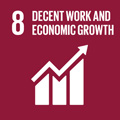- Docente: Rainer Andergassen
- Credits: 6
- SSD: SECS-P/02
- Language: English
- Teaching Mode: Traditional lectures
- Campus: Rimini
- Corso: Second cycle degree programme (LM) in Resource Economics and Sustainable Development (cod. 8839)
-
from Feb 11, 2025 to Mar 18, 2025
Learning outcomes
The purpose of this course is to enable students to rigorously analyse the complex relationship between growth, development and the supporting resource base. Students will be led to analytically assess the possibility and consequences of decreasing returns on living standards and welfare. Although theoretical and general, formal analysis will be complemented by historical reference to acquire a methodological approach relating abstract analysis to actual historical record. Mathematical methods will be used to deal with innovation-led growth but the implicit costs in terms of pollution will be carefully considered. Students will learn that environmental policies are an essential part of the process of development. It will be shown that pollution abatement methods are to be fully considered in the economy production core and as crucial determinants of the overall rate of growth. It is an object of the course to shed light on the implicit race between increasing productivity and decreasing returns to natural resources suggesting that, in the long run, the race has no apparent winner.
Course contents
Learning outcomes
The course introduces students to the main issues in sustainable economic development. In particular, students will learn what the main facts of economic growth are; why poverty in some countries persists; why countries are at different stages of economic development; why some countries converge in terms of income per capita and why some others diverge; how to combine economic development and environmental sustainability.
Contents
1. Development and sustainability: questions and issues
2. Introduction to economic growth theory
3. Convergence and Divergence
4. From stagnation to growth
5. Poverty traps
6. Growth and the environment
Readings/Bibliography
Aghion, Philippe and Peter Howitt, 2009. The Economics of Growth. MIT Press.
Galor, Oded, 2005, From Stagnation to Growth: Unified Growth Theory, Handbook of Economic Growth, 2005, 171-293
Galor, Oded and David N. Weil, 2000, Population, Technology and Growth: From Malthusian Stagnation to the Demographic Transition and Beyond, American Economic Review, 90, 806-828
Ghatak, Maitreesh, 2015, Theories of Poverty Traps and Anti-Poverty Policies, World Bank Economic Review, 29, S77-S105
Jones, I. Charles, 2016. The facts of Economic Growth. Forthcoming, Handbook of Macroeconomics 2A, Ch1.
Matsuyama, Kiminori, 2011, Imperfect Credit Markets, Household Wealth Distribution, and Development, Annual Review of Economics, 3, 339-362.
Sachs, Jeffrey D., 2015. The Age of Sustainable Development. Columbia University Press.
Links to papers and books are available on virtuale.unibo.it
Teaching methods
Traditional lectures. Slides will be available on virtuale.unibo.it
Assessment methods
Grading (out of 30) will be as follows:
- 50% Written test (essay) on topics discussed during lectures
- 50% research project
Written test: Questions are going to be like the research questions you see at the beginning of each topic.
The exam will be open book (you can use lecture notes, presentations, books ...) with two questions to be answered with paper and pen in 45'.
The research project, to be handed in at a later date, should be 2/3 pages long and contain the following: background, research question and methodology (data sources and model).
Grading is as following:
-
<18 fail
-
18-23 sufficient
-
24-27 good
-
28-30 very good
-
30L excellent
Teaching tools
Slides and reading material are available on virtuale.unibo.it.
Office hours
See the website of Rainer Andergassen
SDGs



This teaching activity contributes to the achievement of the Sustainable Development Goals of the UN 2030 Agenda.
